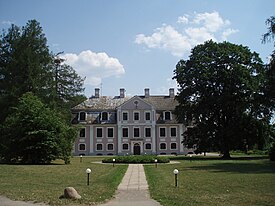
Valga County is a first-level administrative unit and one of 15 counties of Estonia. It comprises the former area of Valga District. The present-day county was created on 1 January 1990. The capital and largest town of Valga County is Valga, followed by Tõrva and Otepää. It is situated in the southern part of the country and borders Põlva and Võru County to the east, Latvia to the south and west, and Viljandi and Tartu County to the north. 27,650 people live in Valga County as of 2022.

Brabrand is a postal district of Aarhus Municipality, Denmark. South of Brabrand, in the Aarhus river-valley, is the largest recreational area of Aarhus Municipality, comprising the Brabrand Lake and the meadow-lake of Årslev, with surrounding natural sites.

Madona is a town with town rights in the Vidzeme region of Latvia and is the center of the Madona municipality.

Vidzeme is one of the Historical Latvian Lands. The capital of Latvia, Riga, is situated in the southwestern part of the region. Literally meaning "the Middle Land", it is situated in north-central Latvia north of the Daugava River. Sometimes in German, it was also known as Livland, the German form from Latin Livonia, though it comprises only a small part of Medieval Livonia and about half of Swedish Livonia. Most of the region's inhabitants are Latvians (85%), thus Vidzeme is the most ethnically Latvian region in the country.

Saulkrasti is a town in Saulkrasti Municipality in the Vidzeme region of Latvia, on the east coast of the Gulf of Riga. It is the administrative centre of Saulkrasti Municipality. Made up of a number of historic fishing settlements, the town stretches for some 17 km from the Inčupe river in the south to the village of Skulte in the north. The town itself spans across 4.8 square kilometres (1.9 sq mi) and includes an additional 42 square kilometres (16 sq mi) of fields and forests.
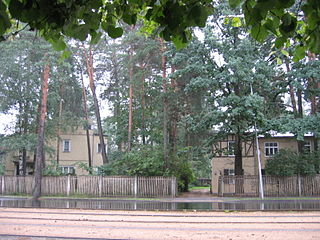
Mežaparks is a neighbourhood of Northern District in Riga, the capital of Latvia. It consists of a residential area to the South and a large urban park to the North of the same name – Mežaparks. The neighbourhood is located on the western shore of Lake Ķīšezers. The name is literally translated as "forest park". The neighbourhood and park were built in the early 20th century and the area was originally called Kaiserwald. It was one of the world's first garden cities. It had large number of Art Nouveau and Eclectic villas for upper class inhabitants of Riga. During the Second World War, the Kaiserwald concentration camp was located in this park, and many Jews, Gypsies, Communists, and other opponents of Nazi rule were murdered in these woods.
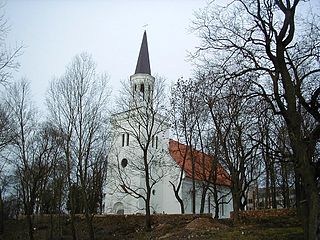
Iecava is a town on the via Baltica in Bauska Municipality, in the Semigallia region of southern Latvia. The town has a population of around 9700 people. Iecava lies 40 km south of Riga and 23 km north of Bauska and was mentioned in historical documents as early as 1492. Until the 2021 Latvian administrative reform took into force on 1 July 2021, Iecava was a village and the center of Iecava Municipality.

Mērsrags is a small harbor town in Talsi Municipality in the Courland region of Latvia, located on the west coast of the Gulf of Riga beside Lake Engure and surrounded by extensive woodlands. The total area of the former Mērsrags municipality was 109 km2, 63.7% of this area was woodland and Lake Engure covered 20.4%, the coastline was about 12 km long. The town center is some 42 km from Talsi, the main city of the area and some 95 km from the capital, Riga.

Ādaži Municipality is a municipality in the historical region of Vidzeme, and the Riga Planning Region in Latvia, which consists of Ādaži and Carnikava Parish plus the administrative centre, Ādaži. The municipality is located 25 km from the center of Riga.

Carnikava Municipality is a former municipality in Vidzeme, Latvia. The municipality was formed in 2006 by reorganization of Carnikava Parish of the Riga District, with the administrative centre being Carnikava. The population in 2009 was 6,261 people.

Koknese Parish is an administrative unit of Aizkraukle Municipality in the Vidzeme region of Latvia. The parish center is Koknese, although as a town it is located outside the parish.
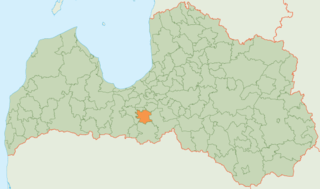
Iecava Municipality is a former municipality in the historical region of Semigallia, and the Zemgale Planning Region in Latvia. The municipality was formed 2003 by a reorganization of Iecava Parish, the administrative centre being Iecava. The municipality consisted of the following settlements: Audrupi, Dimzukalns, Dzelzāmurs, Dzimtmisa, Iecava, Rosme, Vanči, Zālīte, Ziemeļi, Zorģi. The population in 2020 was 8,353.

Ozolnieki Municipality is a former municipality in Semigallia, Latvia. The municipality was formed in 2003 by merging Ozolnieki Parish and Cena Parish; the administrative centre was Ozolnieki. In 2009 it absorbed Sidrabene parish of the former Jelgava District. The population in 2020 was 10,019.
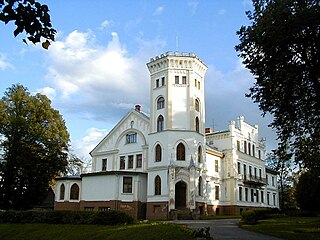
Lizums Parish is an administrative territorial entity of Gulbene Municipality in the Vidzeme region of Latvia. It was an administrative unit of the former Gulbene District. The administrative center is Lizums.

The Ethnographic Open-Air Museum of Latvia is an open-air museum located just outside Riga, the capital of Latvia, on the lightly wooded shores of Jugla Lake.

Dzelzava Manor is a manor house in Dzelzava Parish, Madona Municipality in the Vidzeme region of Latvia. It was built in Baroque style and completed in 1767. Damaged by fire in 1905, it was fully restored to its original appearance in 1908 under the guidance of architect Vilhelms Bokslafs. The building currently houses the Dzelzava primary school.

Madona Municipality is a municipality in Vidzeme, Latvia. The administrative center is Madona.

Salacgrīva Municipality is a former municipality of Latvia. It was created as a result of the territorial reform in 2009, which united several former parts of Limbaži region - Salacgrīva town with its rural areas, Ainaži town with its rural territory and Liepupe Parish. Salacgrīva municipality is bordered by Aloja and Limbaži municipalities and Estonian Pärnu circuit. The centre of the municipality was Salacgrīva. The population in 2020 was 7,152.

Smiltene Municipality is a municipality in Vidzeme, Latvia. The municipality was formed in 2009 by merging the town of Smiltene with the rural parishes of Bilska, Blome, Branti, Grundzāle, Launkalne, Palsmane, Smiltene and Variņi. During the 2021 Latvian administrative reform, the previous municipality was merged with Ape Municipality and Rauna Municipality.
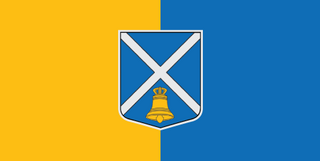
Iecava parish is one of the territorial units of Bauska Municipality in its north. The parish includes the city of Iecava from all sides. It is bordered by Code, Dāviņi, Mežotne, Stelpe and Vecumnieki parishes of its own Municipality, Salgale parish of Jelgava Municipality, Baldone parish of Ķekava Municipality and Olaine parish of Olaine Municipality. From 2003 to 2021, Iecava Municipality was located on its territory.
